Recommendations are open for the 2015 James Tiptree, Jr. Literary Award, send us yours!
The 2013 Tiptree Award winner has been selected!
N.A. Sulway’s imaginative and highly original novel tells the story of Rupetta, an artificial intelligence created 400 years ago from cloth, leather, and metal, brought to life by the touch of her creator’s hand on her clockwork heart.
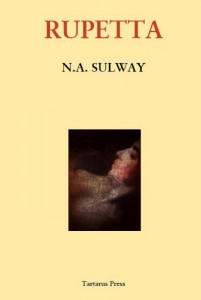
Although Rupetta is a constructed being, she is not a robot. Her consciousness is neither digital nor mechanical. Nor is she an android, a creature that is, etymologically, male. (The word is not gyndroid). Rupetta’s power does not come from her brain, but from her heart. Sulway has placed her construct not in the future, but the past, and made her female, created with traditionally feminine technology: sewing and weaving. Rupetta is a woman, made by a woman in the image of a woman, and the world changes to accommodate her existence.
A deft blend of fantasy, science fiction, romance, and even gothic horror, this beautifully written story challenges the reader’s expectations about gender and of a gendering society. It examines power and what makes an object of power, relationships and love, sexuality and identity, and how culture is shaped and history is made.
Rupetta was published by British independent publisher Tartarus Press in a limited hardback edition and a more widely available e-book version. Both are available for purchase from Tartarus’s website.
Nike Sulway lives and writes in Queensland, Australia. Her novel The Bone Flute won the Queensland Premier’s Literary Award for Best Emerging Author in 2000. Since 2007, she has been the co-director of Olvar Wood Writers Retreat, and one of the editors of Perilous Adventures, a literary magazine.
In addition to selecting the winner, the jury chooses a Tiptree Award Honor List. The Honor List is a strong part of the award’s identity and is used by many readers as a recommended reading list for the rest of the year. This year’s Honor List is:
- Eleanor Arnason, Big Mama Stories (Aqueduct Press 2013) — Big Mamas are galaxy-sized women, powerful beings who can stroll around space and travel through time by sheer force of character. They are feminist, sensible, and adventurous. They come in all kinds of colors, and they survive by their wits, sometimes aided and abetted by Big Poppas. In these five stories, Arnason offers a new mythos, laced with both humor and wisdom.
- Aliette de Bodard, Heaven Under Earth (Electric Velocipede #24, Summer 2012) — In a world with few biological women, some men have been medically altered to carry children and live as wives. When a new wife who was born a woman in a household, her presence causes Liang Pao, an altered man, to scrutinize to scrutinize his reasons for wanting to keep the status quo and to re-examine his own sexuality and feelings towards family, culture, status, and gender.
- Nicola Griffith, Hild (Farrar Straus & Giroux 2013) — This stunningly beautiful historical novel describes what life might have been like for a woman whose mother has arranged for her to be “the light of the world”: the real-life St. Hilda of Whitby. In a rollicking good read, the reader is drawn into action and adventure as Hild becomes a king’s seer, a warrior, and a vessel through which the dynamics of power and gender in war-ravaged 7th-century Britain can be explored.
- Alaya Dawn Johnson, The Summer Prince (Arthur A. Levine 2013) — Set in a somewhat dystopic matriarchal future Brazil, this lavish, provocative YA novel centers on June Costa, a rebellious teenage artist. She and her best friend Gil become entwined with Enki, the Summer King, who is elected to a position of celebrity and social eminence for one year before he becomes a ritual sacrifice. This book grapples with the nature of love, social and political conscience, creative rebellion and personal awakening, and an exploration of sexuality remarkable for its treatment of bisexuality and multiple relationships.
- Ann Leckie, Ancillary Justice (Orbit 2013) — This political revenge story draws the reader into a fraught and ruthlessly colonizing military galactic empire. The protagonist is a human being whose consciousness began as a spaceship inhabiting dozens of bodies and vessels. Now stranded in one body, she bides her time and plots against the leader of the culture she once unquestioningly served. The story examines the brutality of occupation as well as exploring questions of gender and embodiment within a cultural framework that does not recognize gender, only class.
- Bennett Madison, September Girls (HarperTeen 2013) — In this young adult fantasy, a young man named Sam spends a summer in a beach town where he encounters numerous Girls with mysterious pasts that even they have a hard time recalling. Exploring the myth of mermaids and gods of the deep through an examination of gendered power dynamics, Sam learns how to become a man in ways that differ from the models he’s been supplied with by his somewhat clueless father, abrasive older brother, and American culture in general.
- Sarah McCarry, All Our Pretty Songs (St. Martin’s 2013) — A modern-day retelling of the myth of Orpheus, this is the story of two teenagers who grew up closer than sisters despite their parents’ drug-fueled rock-star baggage. The girls’ relationship is tested when the mysterious Jack moves to town, along with strange and disturbing otherworldly interest in his musical talent. The lyrical beauty of the writing and the way the story’s concerns support the value of all of the girls’ relationships (not just the romantic ones) make this contemporary myth surprising and affecting.
- Janelle Monae, Electric Lady (Bad Boy Records 2013) — Janelle Monae’s lastest album is a musical work of science fiction, the latest installment in the conceptually rich world of Cindi Mayweather, a prototype android. A cross-medium Afrofuturist fable, loosely inspired by Fritz Lang’s 1927 film Metropolis, Electric Lady has dramatic scope, powered by magnetic waves of sound and rhythm.
- Helene Wecker, The Golem and the Jinni (Harper 2013) — This debut novel combines elements of Jewish and Arab folk mythology in an immigrant tale, the story of two supernatural creatures in 1899 New York. Ahmad is a jinni, a “man” made of fire. Chava is a golem, a “woman” fashioned of clay. A golem is traditionally male. By making Chava a female figure, Wecker expands this well-trod fantasy element. Although she is a powerful and supernatural being, Chava discovers that in 19th-century New York, her choices and freedoms are limited by the gender of the body she inhabits.
- S. M. Wheeler, Sea Change (Tor 2013) — This debut novel tells a dark, fairy tale-like story of a young girl and her best friend, Octavius, who is an eloquent, intelligent kraken. When Octavius is captured, Lilly sets out to rescue him, bargaining with a greedy circus master, a witch, and a pair of gay bandits. She is transformed by her quest, giving up everything she has known, including her gender, to save her friend.
Nike Sulway will be honored during Memorial Day weekend at WisCon in Madison, Wisconsin. Sulway will receive $1000 in prize money, a specially commissioned piece of original artwork, and (as always) chocolate.
Each year, a panel of five jurors selects the Tiptree Award winner. The 2013 jurors were Ellen Klages (chair), Christopher Barzak, Jayna Brown, Nene Ormes, and Gretchen Treu.
N.A. Sulway’s Acceptance Speech for Rupetta
Delivered May 25, 2014, at WisCon 38 in Madison, Wisconsin:
I would like to thank Nene Ormes, firstly, for her warm introduction of Rupetta to you, and for her role on the jury. I would also like to thank all of the jury members: Ellen Klages, who acted as the chair, Jayna Brown, Gretchen Treu and Christopher Barzak.
I would like to extend my thanks to the Motherboard of the James Tiptree Award, especially its founding members Pat Murphy and Karen Joy Fowler, not just for their role in this year’s awards, but for their vision in establishing the award, and their ongoing commitment to bringing the works that the Tiptree jurors uncover to the world.
I would also like to send out a special thanks to the indefatigable Jeanne Gomoll, who has been an amazing support and become a dear friend. Her warmth and good cheer have made the process of organizing my trip to Wiscon a pure joy.
Finally, I would like to thank my publishers. Many authors express gratitude to their publishers. In this instance, however, this is more than just a duty I feel I need to fulfill. My gratitude to Ray and Rosalie at Tartarus Press is heartfelt and sincere. I cannot thank them enough for bringing this work to publication. Rupetta was rejected many times before it found a home. It was rejected because it had too many women characters, because it had too many queer characters, because some speculative fiction publishers felt it was too literary for them, while some literary publishers felt it was too speculative. Rosalie Parker, at Tartarus Press, believed in this work from the beginning. She and Raymond Russell, her partner at Tartarus Press, are the fairy godmothers of this book. I cannot thank them enough for their faith in the work, and their hard work in bringing it to publication.
Rupetta begins on November 11, 1619. This is not an accidental, or incidental choice. On that night, almost four centuries ago, a young man by the name of Rene Descartes had three dreams that inspired him—over the rest of his life—to attempt to develop a new, comprehensive method for perfecting human knowledge.
One of his correspondents – Poisson – writes that around this time Descartes planned to build several automaton driven by magnets. Specifically, he had envisaged constructing a dancing man, a spaniel chasing a pheasant, and a flying pigeon.
It is no coincidence that my novel, which deals in part with some of the same philosophical problems that interested Descartes, begins that night.
I want to acknowledge Descartes tonight because he also—incidentally–inspired three of my own dreams, or wishes.
I figure, as this year’s winner of the James Tiptree Award, along with all of the other amazing gifts I have received, I get to claim three wishes.
When I studied Descartes and his work when I was at university, I learned that he was the father of an illegitimate child, Francine. The daughter of a friend’s housemaid (Helena Jans van der Strom). Very little is known about the relationship between Rene and Helena, except that she became his servant. I learned that Descartes planned to have the child removed from her home and her mother in Amsterdam and taken to France to be educated. Unfortunately, Francince died of scarlet fever when she was five years old, in 1640.
Some biographers have claimed that her death haunted Descartes for the rest of his life. But his grief interests me far less than the grief of Francine’s mother.
Rupetta is in some sense a book about compromised mothering. About non-conforming mothers. About mothers who are separated from their children. About grief. And longing.
My first wish is that we—and by we here I mean feminists—learn to speak about mothering in new, honest, complex and powerful ways. Not as an essential aspect of femininity, because it is not that, or as a biological right, but as a process we, as women, are often part of; a process many of us experience as both a source of power, and a means of oppression. As an intimate and deeply private process, and a very public role.
Descartes is, of course, perhaps most famous for the ideas he laid down in his Discourse on the Method and Principles of Philosophy. It is here that he decides that the only thing we can know without any doubt is that we are thinking beings.
That we think, and therefore we are.
My second wish is that we will continue and finally complete the work of undoing the false assumption expressed so powerfully by Descartes that it is our minds—our intellects—that are our only Truth. That our bodies are merely the vessels in which we live. I want to find a way to convince you to understand that we think with our bodies, and feel with our minds.
That we feel, and therefore we are.
Finally, I want to tell you a story that is not necessarily true, but it’s a good story and that, after all, should be enough. In the last years of his life, Descartes was summoned to the court of Queen Christina of Sweden. He was to act as her tutor and intellectual companion. He travelled to Sweden by ship.
Descartes had told the captain and crew that he was travelling with his daughter. No one aboard ship, however, had heard or seen her during the voyage. One night, a terrible storm overtook the ship. The waves were as tall as mountains. The sailors were afraid for their lives. Overcome with terror, and seeking some kind of magical cure for the sea’s fury, the sailors entered Descartes’ cabin. There, they discovered a cabinet, inside which was a living doll: a replica of Descartes’s dead daughter. According to one source, she sat up and turned to face her visitors.
The sailors took the mechanical Francine up on to the ship’s deck and threw her overboard.
My third and final wish is that, one day, we will find a way to encounter the new, the unfamiliar or uncanny, without fear or superstition or terror. That we will not, in that moment when the stranger sits up and turns to us, hurl stones or throw them overboard. But instead find a way to open our minds and hearts and embrace that strangeness on its own terms. With courage, and grace, and full acceptance.
N.A. Sulway accepts the 2013 Tiptree Award for Rupetta
On May 25, in Madison, Wisconsin, at WisCon 38, N.A. Sulway accepted the Tiptree Award for Rupetta.

The Tiptree Award is especially pleased that the publishers of Rupetta have published a paperback edition of the book as a direct result of its receiving the award.As is traditional, Sulway received a check for $1,000, a certificate of winning, a box of home-made chocolates, a Tiptree t-shirt (designed by Freddie Baer), a Space Babe cloisonne pin, and a piece of original artwork. Rupetta‘s protagonist has a clockwork heart, we commissioned Carl Cone to make one for Nike.
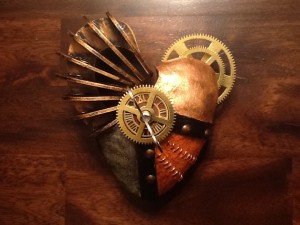
Nike gave an especially remarkable acceptance speech, which we are delighted to share with you all here
The 2014 jury is reading now
The 2014 jury is reading now. Jurors are Darrah Chavey (chair), Elizabeth Bear, Joan Haran, Alaya Dawn Johnson, and Amy Thomson. Please recommend stories, books, and other works that explore and expand gender, using the link to the left of this column.
Caitlin Kiernan wins the 2012 Bram Stoker Award
The Drowning Girl by Caitlin Kiernan didn’t only win the Tiptree Award; it also just won the Bram Stoker Award for Superior Achievement in a Novel, presented in New Orleans in June 2013. Coincidentally, we brought Caitlin’s Tiptree prizes to her that same weekend. Her art award was designed by Catherine Crowe and consists of a beautifully designed box which incorporates a removable magnetic brooch.
Andrea Hairston Accepts 2011 Tiptree Award
Andrea Hairston accepted her 2011 award for her novel Redwood and Wildfire at WisCon 36 in May 2012. She was also WisCon’s co-Guest of Honor with Tiptree Award motherboard chair Debbie Notkin.
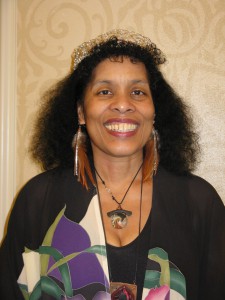
Andrea’s art award is a double doll designed and created by Madeleine Robins. The fabric was designed by Nalo Hopkinson, who also provided design assistance. This doll represents the character Redwood until you flip up the skirts and turn the doll the other way up, at which point it becomes Wildfire.
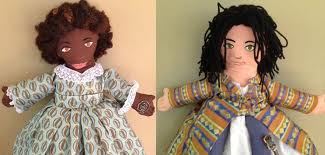
Hairston also received $1000 in cash, the traditional chocolate (this year’s was handmade by Alan Bostick), a plaque, a Tiptree t-shirt designed by Freddie Baer, and a Space Babe pin. The impromptu chorus known as “the Tips” serenaded her with a song based on Woody Guthrie’s “This Land Is Your Land,” accompanied by David Emerson on electric piano. For the duration of the convention, she got to wear the Tiptree tiara, designed by Elise Matthesen.
2012 Otherwise Award Jury
Now that the 2011 Tiptree Award has been announced, the 2012 jury is starting work. We are delighted to welcome Joan Gordon as a returning Tiptree Award chair. Joan will be working with the stellar jury team of Andrea Hairston, Lesley Hall, Karen Lord, and Gary Wolfe. Something exciting will come of this.
Dubravka Ugresic accepts Tiptree Award
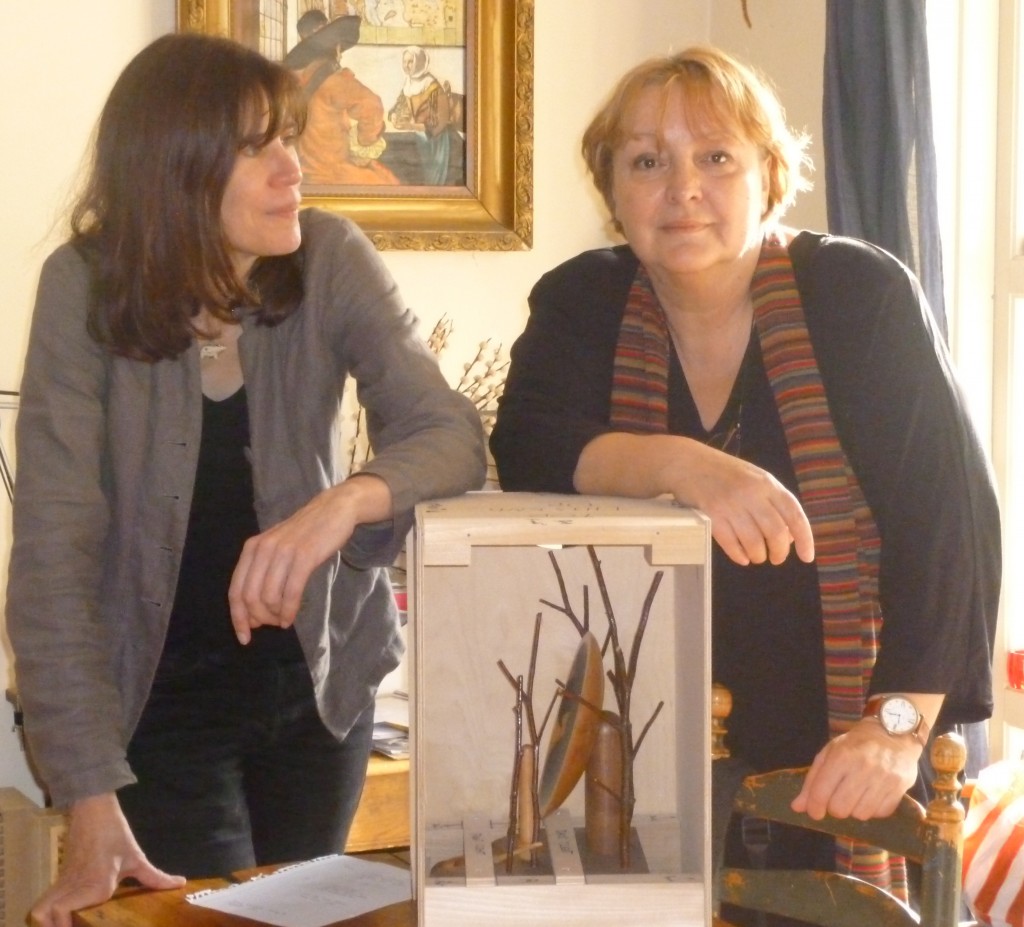
Dubravka Ugresic accepts Tiptree Award artwork and certificate. Because Ms. Ugresic lives in Amsterdam and couldn’t come to WisCon, James Tiptree’s biographer Julie Phillips got together with her to give her the original artwork by Johnna Y. Klukas. Here’s a picture of Julie Phillips, Dubravka Ugresic, and the artwork.
Dubravka Ugresic honored for Tiptree Award
Although Dubravka Ugresic was unable to attend, we honored her in absentia at WisCon 35. The beautiful original art trophy by Johnna Klukas was on display in the WisCon art show. The trophy, the traditional chocolate, and her award certificate will be given to Ugresic in August by our woman in Amsterdam, Julie Phillips (author of James Tiptree, Jr.: The Double Life of Alice Sheldon
